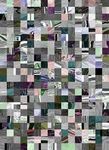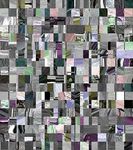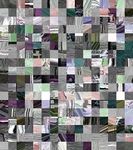Lapped Cuboid-based Perceptual Encryption for Motion JPEG Standard
←
→
Page content transcription
If your browser does not render page correctly, please read the page content below
Proceedings, APSIPA Annual Summit and Conference 2018 12-15 November 2018, Hawaii
Lapped Cuboid-based Perceptual Encryption for
Motion JPEG Standard
Kosuke Shimizu∗ , Taizo Suzuki† , and Keisuke Kameyama†
∗ Department of Computer Science, University of Tsukuba, Japan
E-mail: shimizu@adapt.cs.tsukuba.ac.jp
† Faculty of Engineering, Information and Systems, University of Tsukuba, Japan
E-mail: {taizo, Keisuke.Kameyama}@cs.tsukuba.ac.jp
Abstract—This paper proposes cuboid-based perceptual en-
cryption (Cd-PE) and a version of cube-based perceptual encryp-
tion (C-PE), named lapped cuboid-based perceptual encryption
(LCd-PE), to enhance the security for Motion JPEG (MJPEG).
Although C-PE provides a high level of security by dealing with
several frames of the input video sequence simultaneously, keyless
attackers may illegally decrypt the encrypted video sequence
with conceivable attacks such as a cube-based jigsaw puzzle
solver (CJPS) attack. LCd-PE subdivides the video sequence pre-
encrypted with C-PE into small cuboids and further encrypts
it so that attackers cannot conduct attacks such as CJPS.
The experiments show that the compression performance of an
encryption-then-compression (ETC) system with LCd-PE and
MJPEG is almost equivalent to that of one using C-PE and yet
achieves a higher level of security. Fig. 1. LCd-PE consists of C-PE and Cd-PE.
I. I NTRODUCTION
Multimedia communications on unsecured channels have hand, [2], [3] focused on encryption during compression for
been regarded as dangerous. Such communications include Advanced Video Coding (AVC) and High Efficiency Video
open systems such as social networking services (SNSs) Coding (HEVC), which are popular international compression
allowing the anyone to see the uploaded contents except standards. We previously presented an ETC system with a
for login/logout and video on demand (VoD) and Pay TV cube-based perceptual encryption (C-PE) for MJPEG in [4],
controlling the quality of sent content. On the other hand, they because it is quite difficult to encrypt the input content before
do not include login/logout video on demand (VoD) and Pay AVC or HEVC due to intra and inter predictions. Our system
TV systems controlling the quality of the sent contents. Open achieved a high level of security by processing the frames of
systems have different requirements for achieving both com- the input video sequence simultaneously, but at the expense of
pression efficiency and real-time processing for applications a though real-time decryption ability. To be more specific, it
using the saved content. For SNSs, a suitable security level is regards the whole video sequence as a large cuboid, divides it
determined according to a trade-off with the compression ratio into small cubes, and applies C-PE consisting of cube rotation,
of the encrypted content, because communications are band- cube scrambling, cube negative-positive (nega-posi) reversal,
limited. For VoD and Pay TV, the suitable security level is and cube color component shuffling to the small cubes. C-PE
determined according to a trade-off with real-time processing provides a high level of security by dealing with several frames
requirement in decoding, because their content should be sent of the input video sequence simultaneously. However, keyless
without delay. attackers may attempt to decrypt the encrypted video sequence
The conventional encryption schemes [1]–[3] have to be illegally with conceivable attacks such as a cube-based jigsaw
compatible with existing compression frameworks and able to puzzle solver (CJPS) attack.
decrypt video sequences in real-time. Most of them encrypt This paper proposes cuboid-based perceptual encryption
content on a per frame basis while hardly modifying the (Cd-PE) and a version of conventional C-PE, named lapped
coefficients of the content being compressed. Because of that, cuboid-based perceptual encryption (LCd-PE), to enhance the
keyless attackers may try to forcibly decrypt the encrypted security for MJPEG (Fig. 1). Fig. 1 shows that LCd-PE works
coefficients with only one frame. In particular, [1] focused on by combining complete encryption with C-PE and partial
the encryption-then-compression (ETC) system for the Motion encryption with Cd-PE. When LCd-PE is applied, the cubes of
JPEG (MJPEG) standard, which encrypts the input content the same size created by C-PE are subdivided into cuboids of
before the international compression standard and can decrypt various sizes. The LCd-PE subdivides the video sequence pre-
the content even if it is recompressed later. On the other encrypted with C-PE into small cuboids and further encrypts
978-988-14768-5-2 ©2018 APSIPA 2022 APSIPA-ASC 2018Proceedings, APSIPA Annual Summit and Conference 2018 12-15 November 2018, Hawaii
it so that attackers cannot conduct attacks such as CJPS. Our B. Advantage and Disadvantage
experiments show that the compression performance of an Unlike other frame-based encryptions [1]–[3], C-PE en-
ETC system with LCd-PE and MJPEG is almost equivalent crypts several frames simultaneously. In addition, the cube
to that of the C-PE case and yet achieves a higher level of rotation produces spatiotemporal sides, which affect the com-
security. pression efficiency depending on the input video sequence,
in the observed frame. Thus, C-PE indeed precludes keyless
II. C UBE - BASED P ERCEPTUAL E NCRYPTION
decryption of only a single frame. However, the encrypted
A. Method Details video sequence may be illegally decrypted by concatenating
C-PE consists of cube rotation, cube scrambling, cube nega- cubes of uniform sizes, i.e., by conducting the CJPS attack.
posi reversal, and cube color component shuffling (Fig. 2 In this paper, we aim to preclude the CJPS attack.
(a)) [4]. It is conducted after dividing the whole input video III. L APPED C UBOID - BASED P ERCEPTUAL E NCRYPTION
sequence, regarded as a large cuboid, into small “cubes”. A. Method Details
Cube rotation rotates smaller cube through four random
The Cd-PE consists of cuboid rotation, cuboid scrambling,
angles: 0◦ , 90◦ , 180◦ , and 270◦ in three directions: depthwise,
cuboid nega-posi reversal, and cuboid color component shuf-
vertically, and horizontally (Fig. 3 (a)). When the cube rotation
fling (Fig. 2 (b)). It is conducted after dividing the whole
is conducted depthwise and vertically, a block in the observed
input video sequence, regarded as a large cuboid, into small
frame is exchanged with a block in another frame. In partic-
“cuboids” whose sizes are ℓV ×ℓH ×ℓD (∀ ℓV , ℓH , ℓD ∈ Z>0 ),
ular, when the depthwise and vertical rotation angles are 90◦
where ℓV , ℓH , and ℓD are vertical, horizontal, and depthwise
or 270◦ , the spatiotemporal sides of the frames appear in the
lengths, respectively.
observed frame. Therefore, C-PE precludes keyless decryption
Cuboid rotation rotates a smaller cuboid through random an-
of only a single frame. However, if the cube rotation is
gles in the horizontal, vertical, and depthwise directions (Fig. 3
applied to MJPEG, the spatiotemporal sides that are usually
(b)). Each angle through which to rotate a chosen cuboid in
not processed with MJPEG appear in the encrypted frames
each direction is determined with random numbers generated
so that the compression efficiency is affected depending on
from a pseudo random number generator (PRNG). The cuboid
the input video sequence. To decrypt the cube-rotated video
is rotated through ∀ θ1 , θ2 ∈ {0, 180}◦ vertically and depthwise
sequence without any decryption key, the attacker must pick
and through ∀ θ3 ∈ {90, 180, 270}◦ horizontally, in accordance
the encrypted blocks from other frames or spatiotemporal
with the random numbers. Unlike in the cube rotation, applica-
sides.
tion of cuboid rotation to MJPEG hardly affects compression
Cube scrambling permutes a pair of two randomly chosen
efficiency because the spatiotemporal sides of the frames do
cubes (Fig. 4 (a)). Exchanging cubes moves the blocks in the
not appear in the observed frame due to angle constraints.
original frames to other frames. To decrypt the cube-scrambled
Cuboid scrambling permutes a pair of two randomly chosen
video sequence without any decryption key, the attacker must
cuboids (Fig. 4 (b)). The two cuboids chosen to be scrambled
pick the encrypted blocks from the other frames, like in the
are selected with random numbers generated from the PRNG.
cube rotation case.
Cuboid nega-posi reversal randomly inverts the colors in
Cube nega-posi reversal randomly inverts the colors in the each smaller cuboid. It is conducted with a binary random
small cubes. Let ∀ c ∈ Ci = {(Ri , Gi , Bi )} and Ci′ be the pixel number generated from the PRNG. In accordance with this
of the ith cube consisting of RGB components Ri , Gi , and Bi number, the inverted colors of the ith cuboid ∀ c ∈ Ci =
and the ith encrypted cube, respectively. The inverted colors {(Ri , Gi , Bi )} are calculated as
in the ith cube are calculated as !"
!" 255 − c (ε2 (i) = 0)
′
′ 255 − c (ε2 (i) = 0) Ci = "Ci . (3)
C i = " Ci , (1) Ci c (ε2 (i) = 1)
Ci c (ε2 (i) = 1)
Cuboid color component shuffling permutes the order of
where εm (n) means an m-ary random number of the nth color components in each cuboid randomly. The cuboid color
cuboid. component shuffling is conducted with a 6-ary random number
Cube color component shuffling permutes the order of the generated from the PRNG. In accordance with this random
color components in each cube randomly. The shuffled order number, each shuffled color components of the ith cuboid is
of the color components in the ith cube is calculated as calculated as
⎧ ⎧
⎪ {(Ri , Gi , Bi )} (ε6 (i) = 0) ⎪
⎪ {(Ri , Gi , Bi )} (ε6 (i) = 0)
⎪
⎪ ⎪
⎪
⎪
⎪ ⎪
⎪ {(Ri , Bi , Gi )} (ε6 (i) = 1)
⎪
⎪ {(Ri , Bi , Gi )} (ε6 (i) = 1) ⎪
⎪
⎪
⎨{(G , R , B )} (ε (i) = 2) ⎨{(G , R , B )} (ε (i) = 2)
i i i 6
Ci′ =
i i i 6
. (2) C′i = . (4)
⎪ ⎪
⎪ {(G , B , R )} (ε 6 (i) = 3)
⎪
⎪ {(G i , B i , R i )} (ε 6 (i) = 3) ⎪
⎪
i i i
⎪
⎪ ⎪
⎪{(Bi , Ri , Gi )} (ε6 (i) = 4)
⎪
⎪ {(Bi , Ri , Gi )} (ε6 (i) = 4) ⎪
⎪
⎪
⎩ ⎩
{(Bi , Gi , Ri )} (ε6 (i) = 5) {(Bi , Gi , Ri )} (ε6 (i) = 5)
2023Proceedings, APSIPA Annual Summit and Conference 2018 12-15 November 2018, Hawaii
(a)
(b)
(c)
Fig. 2. Procedures of three perceptual encryptions: (top-to-bottom) conventional C-PE, Cd-PE, and LCd-PE.
B. Security
The conceivable attacks include the CJPS attack, which
attempts to match cubes, and the algorithmic brute force
(ABF) attack that tries all algorithmic candidates. [5] has
(a) (b)
analyzed the block-based jigsaw puzzle solver (BJPS) attack
Fig. 3. Rotation methods: (a) cube rotation and (b) cuboid rotation. in the block-based perceptual encryption (B-PE) and proved
that choosing an appropriate block size and B-PE method
complicates the task presented to BJPS. Generally, when
attackers match square blocks, they select the pair of sides
that have minimal differences. However, since matching sides
does not also match the intra-block textures when the block
(a) (b) boundaries have distortions, BJPS must also take the intra-
block variance into account. Whereas a CJPS attack against
Fig. 4. Scrambling methods: (a) cube scrambling and (b) cuboid scrambling.
C-PE has not been realized yet, a suitable C-PE with an
appropriate choice of cube size can sufficiently complicate the
task of BJPS, since it involves matching six sides (of a cube
surface) rather than just four (of a block side).
Here, we should note that it is desirable that there are as For LCd-PE, cube-rotated blocks exposing the spatiotempo-
many sizes of cuboid as possible in the encrypted video se- ral direction are more subdivided by Cd-PE. The subdivided
quence. Although one way to achieve this with only Cd-PE is widths are specified with the cuboid sizes, and they are various,
to determine the sizes and coordinates of the cuboids for each as aforementioned. An attacker supposes the size of cubes
Cd-PE operation, it is inefficient because the encryptor does and the number of bundled cuboids and then conducts the
not know the appropriate sizes or coordinates. Therefore, we CJPS attack on the bundled cuboids. Since such an attack
decided to create a simpler encryption applying “partial” Cd- cannot be assured to finish, if the fully attacked video sequence
PE–the overall method is called LCd-PE–to a video sequence is not correctly recovered, the CJPS attack is iterated again.
pre-encrypted with C-PE (Fig. 2 (c)). To achieve partial Cd- Therefore, LCd-PE completely precludes the CJPS attack.
PE, we generate a binary random number from the PRNG, and In addition, the encryptor of C-PE [4] precludes the ABF
when the number is 1, we apply each corresponding Cd-PE attack in real-time. The previous study states that the ABF
operation to a video sequence already pre-encrypted with C- attack against a cube-rotated and cube-scrambled sequence
PE. By iterating these operations, the video sequence is further cannot be concluded in real-time. Since this is an insight
divided and partially encrypted partially. Consequently, when into the case of C-PE with a constant cube size, it means
LCd-PE is applied, the same sized cubes created by C-PE are the difficulty faced by ABF is further increased that when
subdivided into cuboids of various sizes. LCd-PE is used. For example, the cube rotation now has to be
2024Proceedings, APSIPA Annual Summit and Conference 2018 12-15 November 2018, Hawaii
50 50 50
45 45 45
PSNR [dB]
PSNR [dB]
PSNR [dB]
40
40 40
35
35 35
30
30 No encryption 30 No encryption No encryption
C-PE C-PE 25 C-PE
LCd-PE LCd-PE LCd-PE
25 25
0 1 2 3 4 5 6 0 0.5 1 1.5 2 2.5 3 3.5 4 4.5 5 5.5 0 1 2 3 4 5 6 7 8
Bitrate [bpp] Bitrate [bpp] Bitrate [bpp]
(a) (b) (c)
Fig. 5. R-D curve (average of 256 frames): (a) Akiyo, (b) Bowing, and (c) Coastguard.
( ( '
!"'# !"'#
!"&$
!"'&
!"'&
!"'%
!"'% !"&
!"'$
!!"#
!!"#
!!"#
!"'$
!"' !"%$
!"'
!"##
!"## !"%
!"#&
!"#% !"#&
+, &-.$/)#",- +, &-.$/)#",- !"#$ +, &-.$/)#",-
!"#$ 0123 !"#% 0123 0123
405123 405123 405123
!"# !"#$ !"#
! ( $ ) % * & ! !") ( (") $ $") * *") % %") ) )") ! ' ( ) * $ + # %
!"#$%#& '())* !"#$%#& '())* !"#$%#& '())*
(a) (b) (c)
Fig. 6. SSIM performance (average of 256 frames): (a) Akiyo, (b) Bowing, and (c) Coastguard.
conducted on a cube constructed from randomly sized cuboids. 3) Calculate the mean bitrates of the compressed frames.
The cube cannot have the correct thickness and cannot be used 4) Decompress the compressed frames.
to reconstruct the original correct cube. Even if the incorrectly 5) Decrypt the decompressed frames.
constructed cubes are inversely rotated, they cannot match any 6) Calculate the mean PSNRs and mean SSIMs between
of the other ones. Therefore, we can see that LCd-PE is robust the input frames and the decrypted frames.
against both the CJPS attack and ABF attack.
B. Experimental Results
IV. E XPERIMENTS
The rate-distortion (R-D) curves and the SSIM perfor-
A. Experimental Conditions and Procedure mances are shown in Fig. 5 and Fig. 6. The compression effi-
We used three test video sequences [6] with different ciencies of LCd-PE (blue lines) were equivalent to those of C-
moving/stopping area sizes, as shown in Table I and Fig. 7 (a, PE only (purple lines) [4]. This is because the spatiotemporal
d, g). The cube size used in C-PE was set as 16 × 16 × 16 in sides were shown by cube rotation for achieving high security.
accordance with [4], and the cuboid sizes used in LCd-PE were LCd-PE had almost the same compression performance as C-
set as shown in Table II. Since the 16k × 16l (∀ k, l ∈ Z>0 ) PE despite it having a higher level of security.
blocks in the observed frames do not affect the 8×8 processing The results of the whole encryption are shown in Fig. 7.
blocks in MJPEG and MJPEG does not conduct inter-frame The video sequence encrypted only with C-PE (Fig. 7(b, e,
prediction, unlike MPEG2, H.264/AVC, and H.265/HEVC, we h)) is still susceptible to a CJPS attack because the cubes are
can consider that the encryption with 16k×16l×m (∀ k, l, m ∈ observed on the spatiotemporal sides. On the other hand, the
Z>0 ) cuboids hardly affects the MJPEG compression perfor- video sequence encrypted with LCd-PE (Fig. 7(c, f, i)) has
mance (in accordance with [1]). However, the spatiotemporal cuboids of variable depth. Keyless attackers must concatenate
sides shown by cube rotation affect the compression perfor- the cuboids randomly and match them with each other during
mance, as described in [4]. We thus evaluated the MJPEG rotation. Therefore, we can see that LCd-PE indeed precludes
compression performance of video sequences encrypted with the CJPS attack.
LCd-PE. Fig. 8 compares the spatiotemporal (top) images. When only
The common procedure was as follows. C-PE is applied, the cubes are of the same size (Fig. 8 (a)).
1) Apply LCd-PE to the frames. When the cuboid rotation and cuboid scrambling are added,
2) Compress the encrypted frames with libjpeg- finer divisions are generated by randomly specifying the
turbo [7], whose compression qualities are cuboid widths (Fig. 8 (b)). Moreover, when cuboid nega-posi
Q := {10, 20, · · · , 100}. reversal and cuboid color component shuffling are added, more
2025Proceedings, APSIPA Annual Summit and Conference 2018 12-15 November 2018, Hawaii
TABLE I
T EST VIDEO SEQUENCES .
Input video sequence Akiyo Bowing Coastguard
Moving area small medium large
Stopping area large medium small
Size & color depth 288 × 352 × 256, 8-bit RGB
TABLE II
C UBOID SIZES USED IN LC D -PE.
Methods V ×H ×D
Cuboid rotation 16 × 16 × 65
Cuboid scrambling 16 × 16 × 113
(a) (b) (c) Cuboid nega-posi reversal 16 × 16 × 17
Cuboid color component shuffling 16 × 16 × 57
for MJPEG provides the best subdivision with 16 ×
16 × 1 cuboids and worst subdivision with 16 × 16 ×
the number of frames.
• The specified cuboid sizes for each Cd-PE method should
not be multiples of each other.
V. C ONCLUSION
(d) (e) (f) This paper proposed cuboid-based perceptual encryption
(Cd-PE) and a version of conventional cube-based perceptual
encryption (C-PE), named lapped cuboid-based perceptual
encryption (LCd-PE), to enhance the security for Motion
JPEG (MJPEG). LCd-PE subdivides the video sequence pre-
encrypted with C-PE into small cuboids and further encrypts
it so that attackers can not conduct conceivable attacks, such
as a cube-based jigsaw puzzle solver (CJPS). The experiments
showed that the compression performance of an encryption-
then-compression (ETC) system with LCd-PE and MJPEG is
almost equivalent to that of the C-PE case and yet achieves a
the higher level of security.
(g) (h) (i)
ACKNOWLEDGMENT
Fig. 7. Whole encrypted results: (left-to-right) original Akiyo, C-PE of Akiyo,
LCd-PE of Akiyo, original Bowing, C-PE of Bowing, LCd-PE of Bowing, This work was supported by a JSPS Grant-in-Aid for Young
original Coastguard, C-PE of Coastguard, and LCd-PE of Coastguard. Scientists (B), Grant Number 16K18100.
R EFERENCES
[1] K. Kurihara, M. Kikuchi, S. Imaizumi, S. Shiota, and H. Kiya, “An
encryption-then-compression system for JPEG/Motion JPEG standard,”
IEICE Trans. Fundamentals, vol. E98-A, no. 11, pp. 2238–2245, Nov.
2015.
[2] B. Boyadjis, C. Bergeron, B. P. Popescu, and F. Dufaux, “Extended
selective encryption of H.264/AVC (CABAC) and HEVC encoded video
streams,” IEEE Trans. Circuits Syst. Video Technol., vol. 27, no. 4, pp.
892–906, Apr. 2017.
(a) (b) (c) [3] B. Zeng, A. Yeung, S. Kei, S. Zhu, and M. Gabbouj, “Perceptual
encryption of H.264 videos: Embedding sign-flips into the integer-based
Fig. 8. Comparison of spatiotemporal images in Akiyo: (left-to-right) C-PE, C- transforms,” IEEE Trans. Inf. Forensics Security, vol. 9, no. 2, pp. 309–
PE+cuboid rotation+cuboid scrambling, and C-PE+cuboid rotation+cuboid 320, Feb. 2014.
scrambling+cuboid nega-posi reversal+cuboid color component shuffling. [4] K. Shimizu and T. Suzuki, “Cube-based encryption connected prior to
Motion JPEG standard,” in Proc. of APSIPA ASC 2017, Kuala Lumpur,
Malaysia, Dec. 2017, pp. 1–4.
[5] T. Chuman, K. Kurihara, and H. Kiya, “On the security of block
random divisions are generated (Fig. 8 (c)). Therefore, we scrambling-based etc systems against extended jigsaw puzzle solver
can see that the cuboid sizes become variable. The following attacks,” IEICE Trans. Inf. & Syst., vol. E101-D, no. 1, pp. 37–44, Jan.
2018.
features are also found: [6] “Xiph.org Video Test Media [derf’s collection],” https://media.xiph.org/
• When the specified cuboid size is smaller, the Cd- video/derf/.
[7] “JPEG software,” https://jpeg.org/jpeg/software.html.
PE method more finely subdivides the cubes: LCd-PE
2026You can also read



























































